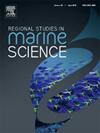南海钦州湾类固醇激素污染特征及风险评价:多源协同效应的结果
IF 2.4
4区 环境科学与生态学
Q3 ECOLOGY
引用次数: 0
摘要
通过海陆一体化监测调查,系统评价钦州湾地区类固醇激素污染特征及生态风险,并进行来源分析。海水和沉积物中分别检测到24种和21种类固醇激素,海水中浓度范围为0.05 ng/L (MT) ~ 3.90 ng/L (E3),沉积物(干重)中浓度范围为0.02 ng/g ~ 2.32 ng/g (P)。在人为划分的5个区域中,海水中类固醇激素的平均浓度趋势为:茂威海养殖区>; 龙门养殖区>; Qinzhou Bay养殖区>; 工业区>; 控制区;沉积物中类固醇激素的平均浓度趋势为:工业区>; 茂威海养殖区>; 控制区>; Qinzhou Bay养殖区>; 龙门养殖区。上述分布特征与类固醇激素的理化性质、区域环境条件和人为因素有关。来源分析表明,钦州湾类固醇激素的发生主要是海水养殖、陆源投入和工业区内多源综合影响的结果。在茅尾海养殖区,类固醇激素与盐度、pH呈负相关,与其他环境参数呈正相关,进一步证实了陆源输入的显著影响。生态风险评价结果显示,MT和EE2为高危区。本研究为钦州湾类固醇激素污染管理和生态风险评价提供了重要参考。本文章由计算机程序翻译,如有差异,请以英文原文为准。
Pollution characteristics and risk assessment of steroid hormones in Qinzhou Bay, South China Sea: A result of multi-source synergistic effects
Through integrated land-sea monitoring and investigation, the pollution characteristics and ecological risks of steroid hormones in Qinzhou Bay area were systematically assessed, and a source analysis was conducted. A total of 24 and 21 types of steroid hormones were detected in seawater and sediments, respectively, with concentration ranges of 0.05 ng/L (MT) to 3.90 ng/L (E3) in seawater, and 0.02 ng/g (MT) to 2.32 ng/g (P) in sediments(dry weight). In the five artificially divided regions, the average concentration trend of steroid hormone in seawater was Maowei Sea aquaculture area > Longmen aquaculture area > Qinzhou Bay aquaculture area > Industrial Area > control area, and the average concentration trend of steroid hormone in sediment was industrial area > Maowei Sea aquaculture area > control area > Qinzhou Bay aquaculture area > Longmen aquaculture area. The above distribution characteristics could be attributed to the physicochemical properties of steroid hormones, regional environmental conditions and human factors. Source analysis indicated that the occurrence of steroid hormones in Qinzhou Bay mainly resulted from the combined influences of mariculture, land-based inputs, and multiple sources within the industrial area. In the Maowei Sea aquaculture area, steroid hormones were negatively correlated with salinity and pH, but positively correlated with other environmental parameters, further confirming the significant impact of terrestrial inputs. Ecological risk assessment revealed that MT and EE2 were classified as posing a high-risk level in this region. This study provided important references for relevant authorities in the management of steroid hormone pollution and ecological risk assessment in Qinzhou Bay.
求助全文
通过发布文献求助,成功后即可免费获取论文全文。
去求助
来源期刊

Regional Studies in Marine Science
Agricultural and Biological Sciences-Ecology, Evolution, Behavior and Systematics
CiteScore
3.90
自引率
4.80%
发文量
336
审稿时长
69 days
期刊介绍:
REGIONAL STUDIES IN MARINE SCIENCE will publish scientifically sound papers on regional aspects of maritime and marine resources in estuaries, coastal zones, continental shelf, the seas and oceans.
 求助内容:
求助内容: 应助结果提醒方式:
应助结果提醒方式:


